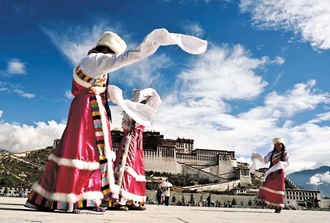The capital of Tibet — often associated with self-immolations by Buddhist monks protesting Chinese rule — is China’s happiest city for the fifth straight year, according to an annual survey of the sense of happiness prevailing among the residents of leading Chinese cities.
Lhasa, capital of the Tibet Autonomous Region, topped a happiness survey conducted by China Central Television based on responses by 100,000 households in 104 cities. Lhasa is nicknamed the “City of Sunlight” because of its perpetually blue skies. The city only gets about 16.8 inches of rain per year. Even during the summer rainy season, the rain tends to fall at night, leaving most days sunny.
Another factor contributing to Lhasa residents’ sense of well being is the low levels of pollution. In a bid to keep air pollution and other environmental degradation to a minimum, the central government has been promoting tourism as Tibet’s main industry while suppressing older polluting industries like manufacturing.
The urban center has a population of about 373,000 while the entire prefecture-level city has a population of 1.1 million. At an elevation of 11,450 feet, Lhasa is the world’s highest major city.
Just below Lhasa was Taiyuan, capital of Shanxi province, Hefei, capital of Anhui province, Tianjin municipality, Changsha, capital of Hunan province, and Hohhot, capital of the Inner Mongolia Autonomous Region.
The most important factor affecting resdients’ sense of well being was income level (55.5%), followed by health (48.9%) and quality of marriage or love life (35%).
Among respondents with an annual income of 100,000 yuan ($15,700) or more, only 6% of respondents reported not having enough free time while 12% of those earning 20,000 yuan or less a year reported a lack of free time.
Capital cities where residents have the most free time include Guiyang, Haikou, Guangzhou, Hangzhou, Lhasa, Chengdu and Chongqing.
Surfing the web and watching TV were named as the two favorite leisure activities. Few respondents reported using free time for education, training, going to the gym or to pursue a social life.
No cities from the Yangtze or Pearl river deltas appeared among the happiest cities. The reason was attributed to a lack of free time to go with their higher income levels, according to Zou Jun, director of the Jiangsu Institute of Urban Planning and Design in Nanjing.
The surveys are seen as helping city administrators plan developments that give due weight to the welfare of residents. For example, many officials focus on landmark buildings or entertainment facilities in city centers, noted Zou. But while such developments may promote a city as a tourist attraction, they aren’t necessarily the best ways to promote a sense of happiness among those who actually live there.


